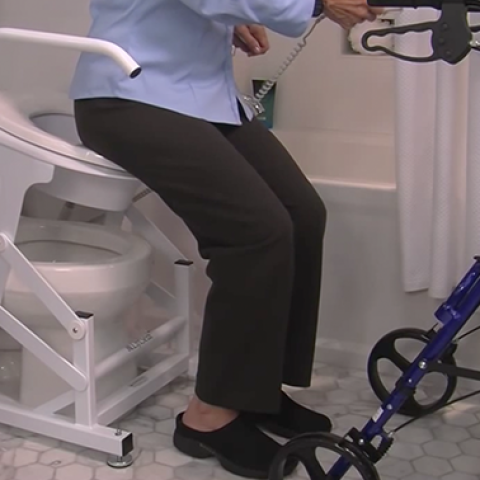Toilet Talk – When Is It Time to Ask for Help Using the Toilet?
02/14/2023
When it comes to using the bathroom, people prefer privacy. This even extends to talking about bathroom-related matters. As painful as talking about toilet troubles can be, taking a tumble on the hard bathroom floor is much more painful.
But how do you know when it’s time to ask for help? Here are a few pointers to help you know when it might be time to get help—and a simple tool to maximize your safety while maintaining your privacy.
I Won’t Need Help…Right?
Not everyone will need help getting on and off the toilet, but most of us will - because as we age, we get weaker. That is not surprising, but the age at which we start getting weaker is.
A recent article on fall prevention points out that we start losing strength when we’re still relatively young. The authors report that, “After the age of 30, strength and endurance decrease by 10% per decade.”1 So, by the time we’re 60, nearly 1/3 of our strength will be gone.
As strength decreases, fall risk increases. “When strength, power, and endurance are decreased, a slip or trip can turn into a fall. Any lower limb disability can increase the risk of falling, and difficulty rising from a seated position in a chair is associated with an increased risk as well.”1
What Does Strength Have to Do with Using the Bathroom?
You may not realize it, but sitting down and standing up require significant lower body strength. As we age and lose strength, sitting down onto the toilet and then returning to a standing position can be difficult.
The CDC published a report looking at bathroom injuries and found that around 234,000 people sustained injuries in the bathroom in a single year. Their data also showed that “injury rates increased with age, and most injuries (81.1%) were caused by falls.” 2 Of these injuries, “the highest rates were for injuries that occurred in or around the tub or shower…and injuries that happened on or near the toilet.” 2
The good news is that many such falls are preventable – especially if you make modifications proactively, before signs of weakness or instability appear.

What Can Be Done to Prevent Toilet-Related Tumbles?
In the same report on bathroom falls, the CDC concludes that “all persons, but especially older adults, should be aware of bathroom activities that are associated with a high risk for injury and of environmental modifications that might reduce that risk.”
There are several simple ways to modify your bathroom (preferably proactively) to make using the toilet easier and safer. Before deciding which one to go with, however, you should consider several factors:
- One important consideration is upper body strength. A common solution people use for help getting off the toilet is a grab bar. This option is popular because it is inexpensive and widely available online and at local hardware stores - but it may not be a good fit for everyone. Grab bars rely on upper body strength, so for individuals who have upper body weakness, they don’t provide ideal support. They also must be installed properly, or they can pull out of the wall and potentially cause injury.
- Another consideration is the level of assistance you require – and how much assistance you are comfortable with. If you need minimal assistance, on-seat toilet risers can be a good option. They are inexpensive, easy to install and make the toilet easier to get on and off by raising the seat height.
If you need more significant assistance, you will need help from someone, or alternatively, a more complete lifting solution. Not everyone has access to family and/or professional caregivers, and those who do would still prefer to use the bathroom alone. For maximum independence, a power toilet lift is a good option.
Power toilet lifts provide complete sit-to-stand assistance. Users can lower and raise themselves at the push of a button. For even greater independence, LiftSeat offers a bidet attachment for hands-free cleaning. LiftSeat units are also compact and easy to install (simply fitting over the existing toilet), so they will work in most bathrooms.
Whether you opt for a grab bar, a toilet riser, or a power toilet lift, the most important thing is to implement this type of equipment before you have an accident (or find yourself in an embarrassing situation like Grace from the hit tv series Grace and Frankie). Falls in the bathroom are painful, expensive and can be truly life-altering, so it’s worthwhile to do a bit of research and find the solution that works for.
References:
- Appeadu, M. K., & Bordoni, B. (2022, January). www.ncbi.nlm.nih.gov. National Library of Medicine - National Center for Biotechnology Information. Retrieved May 20, 2022, from https://www.ncbi.nlm.nih.gov/books/NBK560761/
- Department of Health and Human Services, Stevens, J. A., Haas, E. N., & Haileyesus, T., Nonfatal Bathroom Injuries Among Persons Aged ≥15 Years --- United States, 2008 (2011). Centers for Disease Control and Prevention. Retrieved February 3, 2023, from https://www.cdc.gov/mmwr/preview/mmwrhtml/mm6022a1.htm
This content is not intended to be a substitute for professional medical advice, diagnosis, or treatment. Always seek the advice of your physician or other qualified health provider with any questions you may have regarding a medical condition.